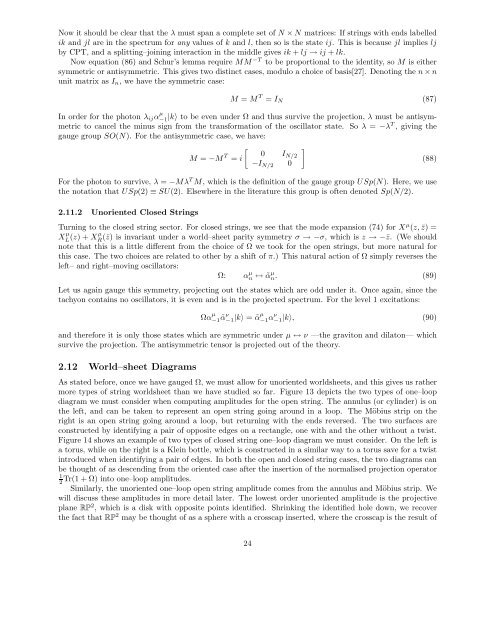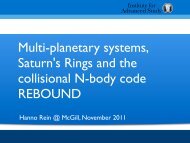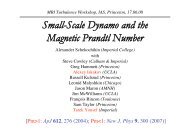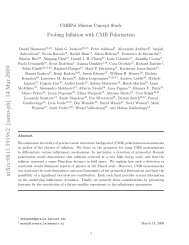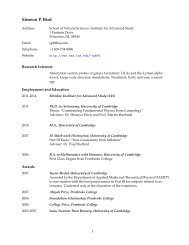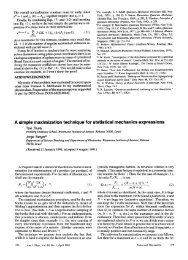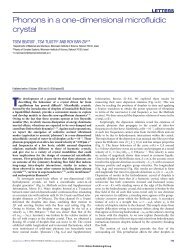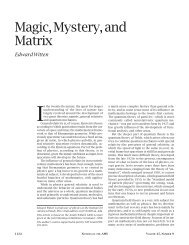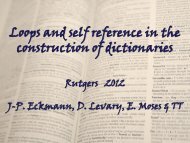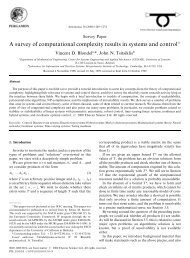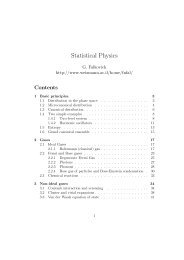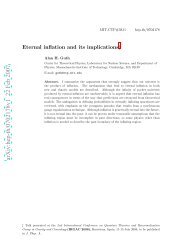Introduction to String Theory and D–Branes - School of Natural ...
Introduction to String Theory and D–Branes - School of Natural ...
Introduction to String Theory and D–Branes - School of Natural ...
You also want an ePaper? Increase the reach of your titles
YUMPU automatically turns print PDFs into web optimized ePapers that Google loves.
Now it should be clear that the λ must span a complete set <strong>of</strong> N × N matrices: If strings with ends labelled<br />
ik <strong>and</strong> jl are in the spectrum for any values <strong>of</strong> k <strong>and</strong> l, then so is the state ij. This is because jl implies lj<br />
by CPT, <strong>and</strong> a splitting–joining interaction in the middle gives ik + lj → ij + lk.<br />
Now equation (86) <strong>and</strong> Schur’s lemma require MM −T <strong>to</strong> be proportional <strong>to</strong> the identity, so M is either<br />
symmetric or antisymmetric. This gives two distinct cases, modulo a choice <strong>of</strong> basis[27]. Denoting the n × n<br />
unit matrix as In, we have the symmetric case:<br />
M = M T = IN<br />
In order for the pho<strong>to</strong>n λijα µ<br />
−1 |k〉 <strong>to</strong> be even under Ω <strong>and</strong> thus survive the projection, λ must be antisymmetric<br />
<strong>to</strong> cancel the minus sign from the transformation <strong>of</strong> the oscilla<strong>to</strong>r state. So λ = −λT , giving the<br />
gauge group SO(N). For the antisymmetric case, we have:<br />
M = −M T <br />
= i<br />
0 IN/2 −IN/2 0<br />
For the pho<strong>to</strong>n <strong>to</strong> survive, λ = −Mλ T M, which is the definition <strong>of</strong> the gauge group USp(N). Here, we use<br />
the notation that USp(2) ≡ SU(2). Elsewhere in the literature this group is <strong>of</strong>ten denoted Sp(N/2).<br />
2.11.2 Unoriented Closed <strong>String</strong>s<br />
Turning <strong>to</strong> the closed string sec<strong>to</strong>r. For closed strings, we see that the mode expansion (74) for X µ (z, ¯z) =<br />
X µ<br />
L (z) + Xµ<br />
R (¯z) is invariant under a world–sheet parity symmetry σ → −σ, which is z → −¯z. (We should<br />
note that this is a little different from the choice <strong>of</strong> Ω we <strong>to</strong>ok for the open strings, but more natural for<br />
this case. The two choices are related <strong>to</strong> other by a shift <strong>of</strong> π.) This natural action <strong>of</strong> Ω simply reverses the<br />
left– <strong>and</strong> right–moving oscilla<strong>to</strong>rs:<br />
<br />
(87)<br />
(88)<br />
Ω: α µ n ↔ ˜αµ n . (89)<br />
Let us again gauge this symmetry, projecting out the states which are odd under it. Once again, since the<br />
tachyon contains no oscilla<strong>to</strong>rs, it is even <strong>and</strong> is in the projected spectrum. For the level 1 excitations:<br />
Ωα µ<br />
−1 ˜αν −1|k〉 = ˜α µ<br />
−1 αν −1|k〉, (90)<br />
<strong>and</strong> therefore it is only those states which are symmetric under µ ↔ ν —the gravi<strong>to</strong>n <strong>and</strong> dila<strong>to</strong>n— which<br />
survive the projection. The antisymmetric tensor is projected out <strong>of</strong> the theory.<br />
2.12 World–sheet Diagrams<br />
As stated before, once we have gauged Ω, we must allow for unoriented worldsheets, <strong>and</strong> this gives us rather<br />
more types <strong>of</strong> string worldsheet than we have studied so far. Figure 13 depicts the two types <strong>of</strong> one–loop<br />
diagram we must consider when computing amplitudes for the open string. The annulus (or cylinder) is on<br />
the left, <strong>and</strong> can be taken <strong>to</strong> represent an open string going around in a loop. The Möbius strip on the<br />
right is an open string going around a loop, but returning with the ends reversed. The two surfaces are<br />
constructed by identifying a pair <strong>of</strong> opposite edges on a rectangle, one with <strong>and</strong> the other without a twist.<br />
Figure 14 shows an example <strong>of</strong> two types <strong>of</strong> closed string one–loop diagram we must consider. On the left is<br />
a <strong>to</strong>rus, while on the right is a Klein bottle, which is constructed in a similar way <strong>to</strong> a <strong>to</strong>rus save for a twist<br />
introduced when identifying a pair <strong>of</strong> edges. In both the open <strong>and</strong> closed string cases, the two diagrams can<br />
be thought <strong>of</strong> as descending from the oriented case after the insertion <strong>of</strong> the normalised projection opera<strong>to</strong>r<br />
1<br />
2<br />
Tr(1 + Ω) in<strong>to</strong> one–loop amplitudes.<br />
Similarly, the unoriented one–loop open string amplitude comes from the annulus <strong>and</strong> Möbius strip. We<br />
will discuss these amplitudes in more detail later. The lowest order unoriented amplitude is the projective<br />
plane RP 2 , which is a disk with opposite points identified. Shrinking the identified hole down, we recover<br />
the fact that RP 2 may be thought <strong>of</strong> as a sphere with a crosscap inserted, where the crosscap is the result <strong>of</strong><br />
24


